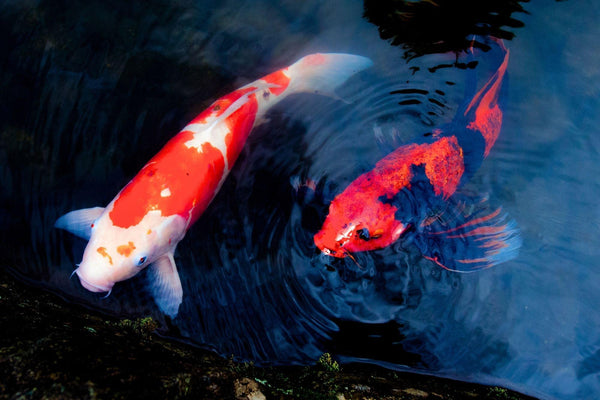
Jump to:
For centuries, koi fish have mesmerized people with their vibrant colors and elegant movements. Originally from Japan, these ornamental fish are much more than just a beautiful addition to ponds; they carry profound cultural significance and symbolize resilience, perseverance, and prosperity.
Koi fish have left their mark not only in gardens but also in art, tattoos, and folklore, becoming an integral part of Japanese culture and extending beyond it.
This article takes you on a journey into the captivating world of koi fish, delving into their rich symbolism in Japanese traditions, the diverse types of koi and their unique traits, and the essentials of keeping them as pets. We’ll also cover their care needs, including their lifespan, diet, and tips for maintaining a healthy environment.
Additionally, we’ll explore how these iconic creatures have inspired art and tattoos, evolving into timeless symbols of beauty and meaning. Whether you're a budding koi enthusiast or a curious novice, this guide will provide insights into what makes koi fish truly extraordinary.
What Are Koi Fish?

Koi fish, scientifically named Cyprinus Rubrofuscus, is a domesticated form of the common carp, selectively bred over centuries for their stunning colors and intricate patterns.
While the origins of the common carp trace back to China, it was in Japan that breeding evolved into a refined art, giving rise to the breathtaking varieties we see today. Their allure lies in their vibrant beauty, shaped by generations of careful breeding and rich cultural symbolism.
Koi, with hues ranging from vivid oranges and reds to radiant whites, yellows, and blues, are often associated with values like success, love, and strength. Some koi, especially those with rare patterns, impeccable symmetry, and vivid pigmentation, can command extraordinary prices, with prize-winning specimens selling for hundreds of thousands of dollars.
Beyond their aesthetic appeal, koi are remarkable for their intelligence and the ability to form connections with their caregivers, often approaching the edge of a pond to interact or even eat directly from their hands.
What Do Koi Fish Symbolize in Japan?

In Japanese culture, both koi and tai fish (bream) hold profound symbolic meanings, each reflecting unique virtues and values. Koi fish are revered as symbols of strength, perseverance, and transformation.
Their cultural significance originates from a Chinese legend of koi swimming upstream and transforming into dragons, embodying resilience and the ability to overcome adversity. An example of this is the use of koi streamers on Children’s Day (May 5), which is part of the Golden Week holidays.
Koi also represent prosperity, good fortune, and personal growth, making them a popular motif in Japanese art, tattoos, and garden ponds. Their vibrant colors carry specific meanings, such as gold for wealth or red for success, further enriching their symbolic value.
In contrast, the tai fish (sea bream) is associated with celebration, joy, and good luck. Its cultural significance stems from its name's connection to "omedetai," meaning "congratulatory" or "auspicious."
Tai fish are often featured in festive settings such as New Year’s celebrations, weddings, and other milestones, symbolizing happiness and prosperous beginnings. Tai is also considered a mark of honor and good fortune in Japanese idioms and traditions.
Taiyaki is a beloved Japanese pastry shaped like a bream and commonly enjoyed as a delightful street food snack. While it is traditionally filled with anko (sweet red bean paste), modern versions feature a variety of fillings, including custard, chocolate, cheese, and even savory options like sweet potato.
While koi emphasize the journey of overcoming struggles and achieving success, tai represent the fulfillment of happiness and shared celebrations. Together, these fish embody complementary aspects of Japanese culture—koi focusing on individual resilience and transformation, and tai celebrating collective joy and prosperity. Both play integral roles in Japanese traditions, reflecting the balance between personal growth and communal harmony.
Types Of Koi Fish
Koi fish, celebrated for their diverse colors and patterns, come in various types, each with unique characteristics and symbolism. Among the most popular varieties are Kohaku, Sanke, and Showa, collectively known as the 'Big Three' or Gosanke in the koi world.
Kohaku

Kohaku, one of the oldest koi breeds established in the 1890s, features a white body with striking red markings. This classic variety symbolizes purity and success, and is admired for its bold, contrasting patterns.
Sanke

Sanke, also called “Taisho Sanke,” emerged in 1914. It builds upon the Kohaku design by adding black markings to the white and red base. The black spots typically don't appear below the lateral line. Sanke represents strength and resilience, with its tri-color pattern admired for its balance and harmony.
Showa

Showa, introduced in 1927, presents a more dramatic appearance with a black base adorned by red and white patterns. Unlike sanke, showa's black markings extend across the head. This variety symbolizes transformation and balance, with the black base representing strength.
These prestigious koi varieties highlight the artistry and precision of Japanese breeding traditions. Each is meticulously bred for specific color patterns, body shapes, and scale characteristics, making them highly prized in gardens and ponds worldwide.
The gosanke varieties exemplify the cultural significance and aesthetic appeal of koi, highlighting their importance in both Japanese tradition and global aquaculture.
Keeping Koi Fish As Pets

Keeping koi fish as pets requires meticulous planning and consistent maintenance to ensure their health and longevity. Koi thrive best in spacious outdoor ponds, which should be at least 1,000 gallons and 3 feet deep to support their growth—often exceeding 24 inches—and provide protection against temperature fluctuations.
Proper filtration and aeration are essential for maintaining high water quality, as koi produce significant waste. Regular water changes and monitoring water parameters, such as pH (7.0-8.0), ammonia, and nitrate levels, are crucial to prevent stress and illness.
Indoor tanks, though less ideal, can also house koi if they are spacious (at least 100 gallons per fish) and equipped with powerful filtration systems. Both environments require good aeration, which can be achieved through air pumps or water features like waterfalls. Maintaining a stable temperature between 65-75°F (18-24°C) is important, sometimes necessitating a pond heater or indoor temperature control.
Koi are omnivores and benefit from a balanced diet of high-quality pellets, supplemented with vegetables or fruits. Additionally, provide shaded areas or floating plants to protect them from excessive sunlight and predators. In colder months, prevent the pond from freezing entirely by using a pond heater or de-icer.
Koi are social and thrive in groups, promoting natural behavior and companionship. Ensuring they have ample space and proper conditions helps them live healthy, vibrant lives. With diligent care, including regular monitoring for signs of illness and maintaining consistent routines, koi fish can be rewarding pets, offering beauty and tranquility to their keepers.
Their longevity, sometimes over 50 years, makes them a long-term commitment that can bring joy for decades.
Koi Fish in Art, Tattoos, and Commercial Designs
Koi fish have long been a profound symbol in Japanese art, embodying perseverance, transformation, and strength. Their graceful movements and vibrant hues have made them a staple in traditional Ukiyo-e prints, ceramics, textiles, and contemporary works.

Picture of Koi Carp and Turtles, Color Painting on Paper
Hokusai, 1813
Renowned artist Katsushika Hokusai, famous for The Great Wave off Kanagawa, depicted koi in his art, capturing their fluid motion and deep symbolic meaning. Koi art bridges ancient folklore with modern expressions, serving as a canvas for spiritual and philosophical themes.
Beyond art, koi hold significant meaning in Japanese tattoo culture. Inspired by the legend of koi swimming upstream to become dragons, these tattoos represent resilience and ambition.

Often depicted with flowing water, waves, or lotus flowers, koi tattoos are deeply personal, symbolizing one’s struggles and triumphs. Their colors also carry specific meanings: gold for wealth, red for love and courage, and black for overcoming adversity.
From historical paintings to body art, koi fish continue to inspire, reflecting the Japanese appreciation for nature, strength, and the journey of life.
This rich symbolism is also reflected in various traditional and modern products found in Japan.
For example, the koinobori (carp streamer) design is beautifully showcased on tenugui cloth, blending cultural heritage with practical artistry. Similarly, a folding fan adorned with koi patterns demonstrates the timeless fusion of traditional craftsmanship and aesthetic beauty.
Koi motifs extend to functional items as well, such as a bento box featuring a stunning koi illustration enhanced with an urushi lacquerware coating. Tai fish, another symbol of prosperity, is also represented in various products.
For a delightful treat, try tai-shaped wafers filled with sweet chocolate. If you're looking for a way to boost your iron intake, consider using a cast iron fish, which can be placed directly into soups or stews.
Koi: A Timeless Symbol Of Beauty And Meaning
Koi fish are more than just ornamental creatures; they symbolize resilience, prosperity, and cultural heritage. Their bright colors and graceful movements captivate people all over the world. In Japanese traditions and folklore, koi hold deep significance, inspiring art, tattoos, and modern design.
A prominent example is koinobori, the colorful carp-shaped windsocks flown during Children's Day in Japan, symbolizing strength and success for children. From their unique types to the careful maintenance required of them as pets, koi represent both beauty and dedication.
Whether valued for their symbolism, artistry, or as long-term companions, koi fish provide a link to nature and remind us of life's struggles and victories. As they swim elegantly through the water, they bring stories of transformation and strength, enriching the lives of those who appreciate them.


0 comments